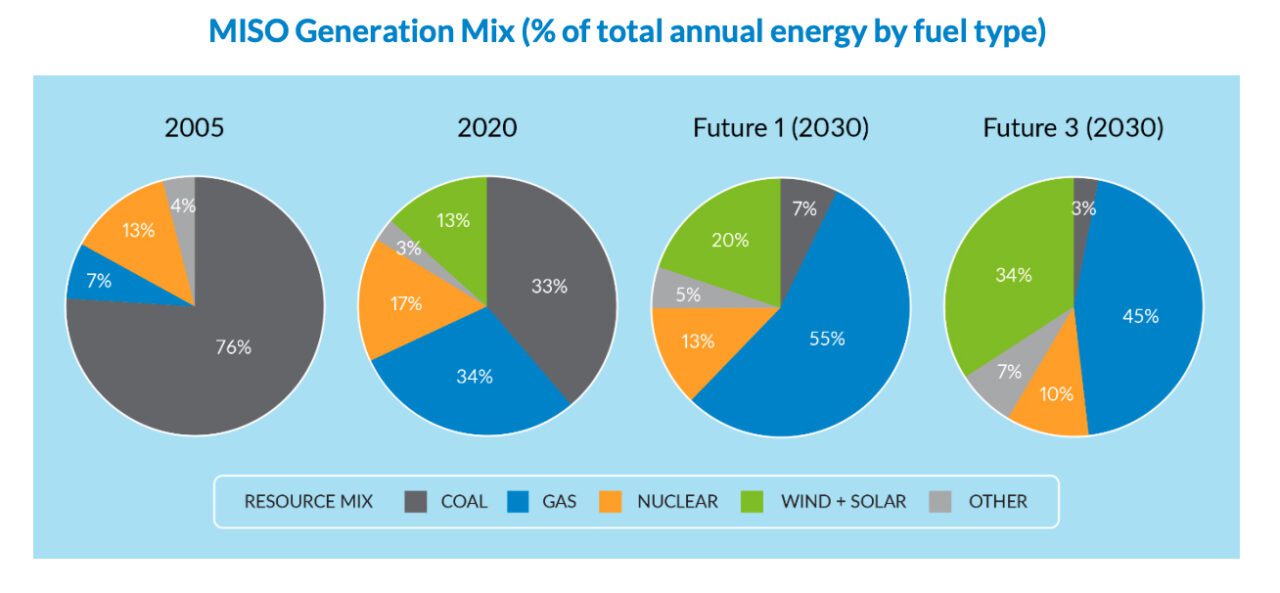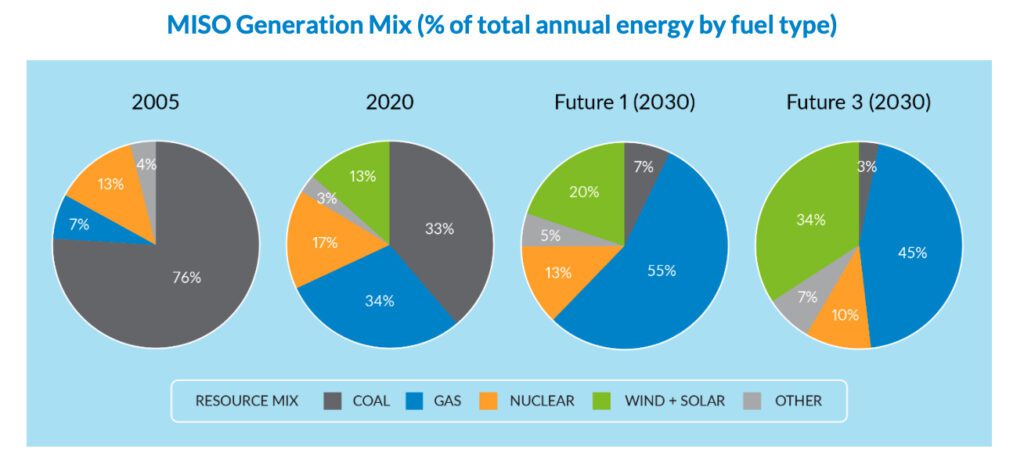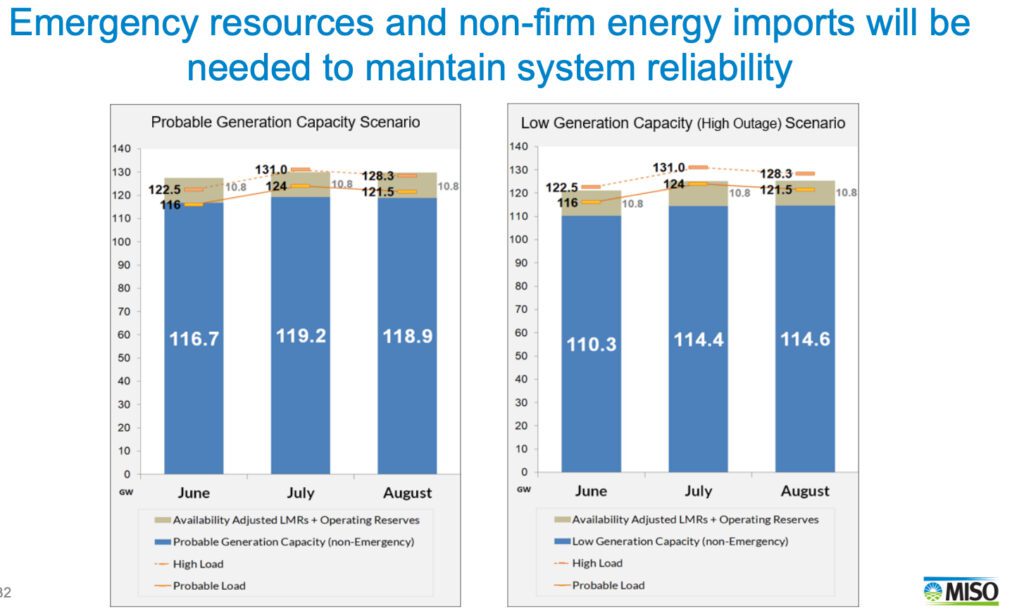ERCOT, MISO Warn of Potential Power Supply Shortfalls

(Updated-May 6, 2022) The Electric Reliability Council of Texas (ERCOT) and the Midcontinent Independent System Operator (MISO) over the past week separately expressed concerns about power supply uncertainties in the face of upcoming warmer-than-normal temperatures.
MISO raised an alarm on April 28 when it said that it projects insufficient firm resources" to cover the summer peak under typical demand and generation outages. It warned: The summer peak forecast is 124 GW with 119 GW of projected regularly available generation within MISO."
The independent system operator, which oversees a grid that spans 15 U.S. states and the Canadian province of Manitoba, called for increased non-firm imports as well as potential emergency resources to meet the 2022 summer peak demand, given that warmer temperatures are forecasted throughout its substantial footprint.
Meanwhile, ERCOT this week warned its Texas grid participants of a possible reserve capacity deficiency, owing to an expected demand surge tied with temperatures of above 94F in North Central and South Central Texas. The grid operator issued several updates to a May 3-issued Advanced Action Notice (AAN) this week to notify participants it could seek between 5.2 GW to 3.2 GW from power plants that are planning outages or are already in outages across the region.
On Thursday, ERCOT issued a second AAN warning of a possible future emergency condition of reserve capacity deficiency for the afternoon and evening hours on Tuesday, May 10, until Wednesday, May 11, suggesting it could seek 2.9 GW from outage adjustments.
However, on Friday, May 6, ERCOT told POWER in a statement that it would not seek additional capacity. Generators and transmission owners have worked with us to reschedule maintenance outages. Those changes, along with a slight drop in forecasted temperatures, have given us sufficient reserves," said ERCOT Vice President Woody Rickerson. With unseasonably warm weather in the forecast, we will continue to monitor conditions so we can reliably operate the grid."
The grid operator added it would continue to deploy all available tools to manage the grid reliably and coordinate closely with the Public Utility Commission, generation resource owners, and transmission utilities to ensure they are also prepared."
While temperatures and grid conditions will ultimately determine how the grid operator responds to ensure system reliability, ERCOT's AANs are still significant given several incidents this year of sudden generation loss, which have at times sent the grid's frequency below 60 Hz.
MISO Warns of Lack of Firm GenerationMISO's warning last week stems from a seasonal assessment following its 2022-2023 Planning Resource Auction. The annual auction's results revealed on April 14 indicated capacity shortfalls in MISO's north and central regions -which include parts of 11 states in the Midwest.
While the auction's Local Clearing Requirement-capacity required from within each zone-was met in the entire MISO region, Zones 8-10 (which includes parts of Arkansas, Louisiana, Mississippi, and Texas) cleared at $2.88/MW-day. However,Zones 1-7 indicated a capacity shortfall, exposing entities with net short" positions to the clearing price of the Cost of New Entry (CONE), which represents the current, annualized capital cost of constructing a power plant. Zones 1-7-which include parts of Illinois, Indiana, Iowa, Kentucky, Michigan, Minnesota, Missouri, Montana, North Dakota, South Dakota, and Wisconsin-all cleared at $236.66/MW-day.
The 2020-21 OMS-MISO survey projected a small surplus for planning year 2022-23, which was eroded by an increased load forecast, less capacity entering the auction as result of retirements, and the decreased accredited capacity of new resources," MISO said as it unveiled the auction results. Its implications are profound: The auction results indicate that MISO North/Central Regions have a slightly increased risk of needing to implement temporary controlled load sheds," the entity added.
 Clearing prices from MISO's 2022-2023 Planning Resource Auction point to capacity shortfalls in four zones. Nearly 8 GW in MISO's north and central regions were exposed to the Cost of New Entry (CONE). Courtesy: MISO
Clearing prices from MISO's 2022-2023 Planning Resource Auction point to capacity shortfalls in four zones. Nearly 8 GW in MISO's north and central regions were exposed to the Cost of New Entry (CONE). Courtesy: MISO
MISO noted accredited capacity in its north and central regions has been steadily falling. Compared to its last auction in 2021, the North/Central zones' capacity fell to 3.2 GW, despite importing more than 3 GW from the south and other external sources. It means that unless more capacity is built that can supply reliable generation, shortfalls such as those highlighted in this year's auction will continue," MISO said.
For some key stakeholders in the power industry, MISO's auction results highlight some under-discussed yet crucial issues. Michelle Bloodworth, president and CEO of America's Power, a trade group representing major American coal producers, utility companies, and railroads, told POWER understanding the concept of accredited capacity" may be key. The dependability of electricity resources varies," she explained. A less dependable resource has a lower amount of accredited capacity-a term used synonymously with unforced capacity, effective load carrying capability, or capacity credit-compared to a more dependable resource."
Bloodworth suggested MISO is expecting capacity shortfalls, owing mainly to two reasons: the low capacity value of renewables (15.5% for wind) and the loss of coal-fired generation which has a much higher capacity value (90-95%)." She added: The bottom line is that MISO has lost 8,300 MW of accredited capacity' in just the last five years. We feel this is information consumers and policymakers need to hear."
MISO Doubling Down on Energy Security With Reliability ImperativeMISO, for its part, has long flagged reliability impacts on its grid from the energy transition. Rapid changes to generation resources and consumption patterns have altered the region's historical summer-centric risk profile, making it more prone to grid emergencies in winter and shoulder-seasons that rarely posed risks in the past," it notes.
Acting with urgency, MISO in December 2020 formed the Reliability Imperative, a collaborative effort that reflects the shared responsibility utilities, states, and MISO" to address reliability challenges. Under the initiative, MISO has so far proposed a set of solutions, including market redefinition," long-range transmission planning, planning for the future, and market system enhancements.
Reliability risks, however, are constantly evolving, it notes. In its latest response to the Reliability Imperative, MISO called attention to declining reserve margins and fewer always-on" baseload resources, mainly due to retirements of thermal units. Outages at aging resources, such as coal units, also pose a substantial reliability risk, and intermittent wind and solar resources are not always available, in part owing to transmission constraints.
 MISO's generation mix. Graphs represent a percentage of total annual energy by fuel type. Courtesy: MISO/MISO's Response to the Reliability Imperative (2022)
MISO's generation mix. Graphs represent a percentage of total annual energy by fuel type. Courtesy: MISO/MISO's Response to the Reliability Imperative (2022)
Fuel availability risks are also notable. The growing fleet of natural gas resources may not be able to procure all the fuel they need at key times, often seasonally based, because of limitations in contractual gas services, lack of dual-fuel capabilities, and reliance on a pipeline system that is shared with heating and manufacturing uses," MISO said. Finally, the region's penetration of distribution-level and behind-the-meter resources is increasing, yet MISO does not have functional control or visibility into how these resources may affect the larger grid system," it said.
Distilling these challenges, MISO has carved out four primary concerns: uncertainty and variability; resource models and capabilities; location; and coordination. Uncertainty and Variability consider new and growing risks, spotlighting energy and flexibility shortages; Resource Models and Capabilities considers the optimal use of resources and their inherent capabilities; Location examines regional differences and transmission limitations; and Coordination explores complexity along the seams (bulk power system and transmission-distribution) and information needs to enhance collaboration and shared visibility," it says.
A Dreaded Summer Ahead for MISOLast week, MISO staff underscored these complexities as they laid out plans to deal with supply constraints during the expected warmer-than-normal summer. Officials at MISO's Summer Readiness Workshop on April 29 warned the region may also be hit by drought conditions, which are already present in MISO South and mainly west of the footprint. Storms across the North and Central and an active hurricane season may also throw in reliability wildcards.
According to Eric Rodriguez, an engineer at MISO's Resource Adequacy Operations, the need for non-firm energy imports may be inevitable to maintain system reliability during peak periods. Referencing the figure below, he explained: The blue represents probable generation capacity-these are resources that cleared the [auction], net of the five-year average generation outages of that month," he said. From the more olive color, you see there are emergency resources-resources that cannot be called upon unless MISO initiates emergency procedures." These include a combination of load modifying resources, including demand response, behind-the-meter generation, as well as some volume of operating reserves.
 MISO's assessment of its summer 2022 resources. Courtesy: MISO
MISO's assessment of its summer 2022 resources. Courtesy: MISO
So you can see for June, July, and August, MISO is projecting the need to call on emergency resources, and hopefully with proper utilization of emergency resources, we'll be able to navigate through this summer," Rodriguez added. However, under a 90/10 higher loads scenario, we're looking like we're going to need to rely on some volume of non-firm energy imports to get through the July period," he said.
MISO said it has already kicked off preparation for the summer season, including training and conducting exercises with member companies to prepare for the worst-case scenarios" and to implement lessons learned and best practices.
We closely monitor the many challenges the summer season can bring and coordinate with our members and other grid operators for situational awareness," said Jessica Lucas, MISO's executive director-system operations in a statement last week. Our members provide us with the details to determine our operational needs and we anticipate tight operating conditions this summer based on their insights."
ERCOT Braces for Tough WeekIn ERCOT, the grid operator tasked with ensuring reliability for 90% of Texas is acting cautiously to ensure demand will not outstrip supply and potentially trigger an emergency condition. ERCOT on May 4 executed an outage adjustment evaluation (OAE) for 3.2 GW, which appears smaller than the 5.2 GW in outages it planned to withdraw or delay on May 3. ERCOT has forecasted load will surge to 59,163 MW on May 6, and up to 67,727 MW on May 10.
ERCOT's spring 2022 seasonal assessment of resource adequacy (SARA), which covers the period between March and May 2022, forecasts a reserve capacity planning reserve margin of 52.5%, which is intended to cover resource outages, lower-than-expected renewable output, and higher-than-expected customer demand. Based on expected spring peak weather conditions, the SARA projected peak demand for spring 2022 would be 64,729 MW. That compares to a total of 94,394 MW of resource capacity that the SARA expects ERCOT will have available for the spring season.
Reserves help ERCOT maintain system frequency at 60 Hz, the industry standard. However, ERCOT's market notices suggest that the grid has fallen below 60 Hz on several occasions after a large sudden loss of generation this year alone. On April 19, the grid experienced a sudden loss of 810 MW of generation, pushing frequency to 59.794 Hz, while ERCOT load was at 44,901 MW. Similar events occurred on April 13, March 12, Feb. 22, Feb. 9, Feb. 4, Jan. 27, and Jan. 14.
Since its Winter Storm Uri debacle, ERCOT has proposed a new market rule requiring generators to report all forced outages. In November, ERCOT staff went a step further, proposing a nodal protocol revision (NPRR1108) that would give ERCOT the authority to approve or deny all planned resource outage requests. ERCOT staff on April 26 won crucial approval from its Board of Directors for the measure, though stakeholders, which comprise ERCOT's Technical Advisory Committee (TAC) had unanimously supported changes. The measure will now be considered by the Public Utilities Commission of Texas (PUCT).
As it currently stands, ERCOT staff reviews and approves only generation outage requests made 45 days or less in advance of the start of a planned outage, while requests made more than 45 days in advance are typically automatically accepted." The NPRR would change that so planned outage requests would be approved on a first-come, first-served basis if aggregate planned outages fall below a daily maximum megawatt limit for each day. ERCOT staff has argued the measure is urgent," given recent regulatory mandates, and because it would mitigate the number of AANs that ERCOT may require to preserve reliability.
TCPA: ERCOT Outage Mandate Poses Another Challenge for Thermal GeneratorsAccording to Michele Richmond, executive director of the Texas Competitive Power Advocates (TCPA), the nodal protocol revision is a very big issue" for TCPA's members, which include power generators that collectively operate over 90% of the non-wind electric generating capacity in ERCOT, including 39 GW of gas-fired generation.
Richmond said TCPA was disappointed" that the ERCOT board chose to reject changes that had been unanimously supported by the stakeholder-comprised TAC. TAC's proposed changes, she said, struck an appropriate balance between generators' maintenance needs with ERCOT's reliability needs."
The restrictive" changes adopted by the board fail to account for the small window currently allotted generators to take planned outages," which currently spans two months in spring and fall, Richmond said. But they also fail to account for the grid's conservative operations and ERCOT's excessive" dependency on reliability unit commitments (RUCs) from the thermal fleet, which will mean more planned outages-not fewer-in order to maintain the viability of the thermal fleet," she said.
TCPA has argued that the ERCOT staff's outage allotments were misconstrued because they rely on the previous three years, a period that spans the pandemic-which Richmond noted was a time in which labor and supply chain constraints resulted in fewer than typical outages." ERCOT's conservative operations since Uri, meanwhile, have run thermal resources more frequently and harder than ever before," she noted.
TCPA is very concerned that the restrictions will risk long-term reliability for the sake of a greater sense of command and control premised on false precision, and result in forced outages when generators are unable to accomplish warranty-required maintenance and other preventative maintenance needed for safe and reliable plant operation within the allotted ERCOT limits," she said. Our fear is that the result will be less visibility and reliability, not more."
TCPA is now counting on the PUCT to move forward with meaningful market design changes." Market design must support investment in dispatchable generation-as the status quo will result in a downward spiral for thermal generation maintenance needs under the adopted version of NPRR1108," Richmond said.
-Sonal Patelis a POWER senior associate editor (@sonalcpatel,@POWERmagazine).
Updated (May 6): Adds ERCOT's statement and details concerning second AAN issued on Friday, May 6.
The post ERCOT, MISO Warn of Potential Power Supply Shortfalls appeared first on POWER Magazine.